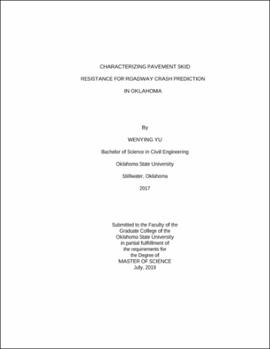| dc.contributor.advisor | Li, Qiang Joshua | |
| dc.contributor.author | Yu, Wenying | |
| dc.date.accessioned | 2021-04-06T16:02:49Z | |
| dc.date.available | 2021-04-06T16:02:49Z | |
| dc.date.issued | 2019-07 | |
| dc.identifier.uri | https://hdl.handle.net/11244/329097 | |
| dc.description.abstract | Skid resistance is critical for roadway safety. This study investigates two approaches to characterizing skid resistance based on pavement texture data and further exploring its effects on roadway crashes in Oklahoma. Skid resistance data were acquired in the field from three friction measurement devices: Grip Tester, a continuous friction measurement equipment (CFME), dynamic friction tester (DFT), and a locked wheel skid trailer. While pavement texture data were obtained using a high-speed profiler and a portable 3D laser scanner with ultra-high resolution. Through a comprehensive field data collection on testing sites with different preventive maintenance treatments in Oklahoma, this study evaluates the repeatability and the impacts of various operational factors on Grip Tester based CFME measurements. An adaptive signal processing technique, Hilbert-Huang transformation, is executed to extract texture characteristics from pavement profiles, which are subsequently correlated to friction measurements. Novel 3D areal texture parameters are calculated at both micro- and macro- scales. The random forest algorithm is implemented to determine the most important texture parameters for the development of friction prediction models. On the other hand, skid resistance and roadway features could have critical effects on highway safety but have not been fully considered to estimate crash rates in the current HSM safety performance functions (SPFs). In this study, four database systems managed by the Oklahoma DOT are utilized to integrate various safety-related roadway features into the SPF development process. Roadway crash data, pavement skid resistance, pavement management system (PMS) condition data, and traffic data from 2012 to 2016 in Oklahoma were acquired for the interstate, selected U.S. and state highways. An enhanced SPF is subsequently developed using negative binomial regression model with a log-linear relationship between crash frequency and roadway features. It is anticipated the work in this study could assist in well-informed decision making in terms of roadway safety for pavement preservation and maintenance practices in Oklahoma. | |
| dc.format | application/pdf | |
| dc.language | en_US | |
| dc.rights | Copyright is held by the author who has granted the Oklahoma State University Library the non-exclusive right to share this material in its institutional repository. Contact Digital Library Services at lib-dls@okstate.edu or 405-744-9161 for the permission policy on the use, reproduction or distribution of this material. | |
| dc.title | Characterizing pavement skid resistance for roadway crash prediction in Oklahoma | |
| dc.contributor.committeeMember | Wang, Kelvin C. P. | |
| dc.contributor.committeeMember | Cross, Stephen Alan | |
| osu.filename | Yu_okstate_0664M_16368.pdf | |
| osu.accesstype | Open Access | |
| dc.type.genre | Thesis | |
| dc.type.material | Text | |
| dc.subject.keywords | continuous friction measurement equipment (cfme) | |
| dc.subject.keywords | crash estimation | |
| dc.subject.keywords | pavement texture | |
| dc.subject.keywords | safety performance function | |
| dc.subject.keywords | skid resistance | |
| thesis.degree.discipline | Civil Engineering | |
| thesis.degree.grantor | Oklahoma State University | |
